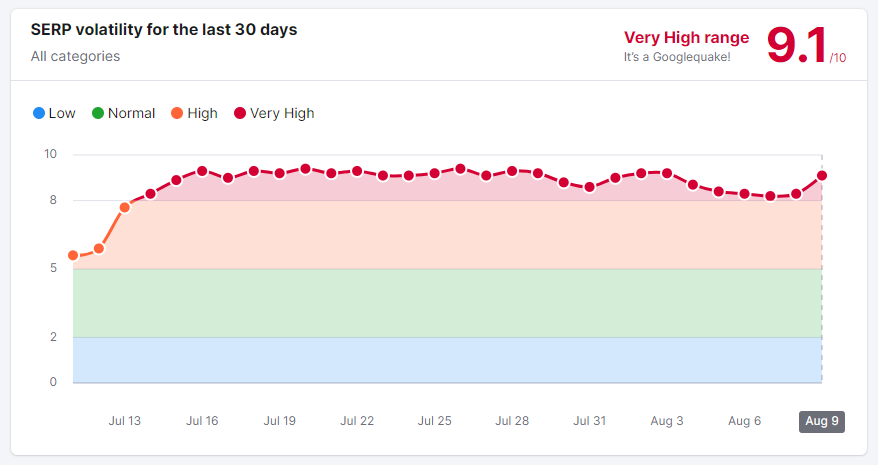Over the last few weeks, SEOs have noticed something strange. Sensors that measure ranking volatility on Search Engine Results Pages (SERPs) have been off the charts lately.
Strangely, volatility has remained high for weeks on end. Usually, we’d expect to see a spike in volatility when a new Google update rolls out. But in this case, volatility has been extreme for many days on end.

The even stranger part is that many SEOs are reporting that for their own sites–and in some cases, their large portfolios of client sites–they’re seeing very little SERP movement.
Jared Bauman of Niche Pursuits recently shared that sentiment on Twitter.
What gives?
Some SEOs have speculated that the rollout of Google’s Search Generative Experience (SGE) is behind the changes. But I have another theory as to what might be going on.
The Death of AI Spam Sites
When OpenAI made GPT-3 and later GPT-4 available through an easy-to-use API, many SEOs immediately jumped into creating massive, pure-AI websites by leveraging generative AI tools.
Some interfaced directly with GPT-4, whereas others used tools that piggyback on the API, providing an easier frontend experience for people who want to generate thousands or tens of thousands of one-click articles.
With generative AI, spinning up a website with 100,000 AI-generated articles is now easy and relatively cheap. And anecdotal evidence suggests that some of these sites climbed in the rankings and did quite well.
While Google has said it has no issues with good AI-generated content, the search engine has made it very clear that they’re against spam of any form. Massive, pure-AI sites with no images, no EEAT, and no human editing of content are clearly spam by Google’s definition.
It makes sense that Google would quickly try to detect and remove these sites from the SERPs. With the recent volatility, I wonder if that’s exactly what’s happening.
A Thought Experiment
Imagine that SEOs spun up 10,000 of these spammy AI sites over the last six months. Each site ranks for 10,000 keywords. Some even rank well.
That’s 100 million keywords that are now dominated by spammy AI content.
Now, imagine that Google releases an update that pulls the plug on 10,000 of those spammy AI sites, all at once (or more realistically for Google, over several weeks.)
What would you see? Massive SERP volatility. The sudden removal of hundreds of millions of spammy pages from the SERPs would result in tons of movement. On the sensors, it would show up as weeks of huge volatility, as pages that were ranking well suddenly disappeared.
That’s very close to what we’re seeing at the moment.
Leaving the Good Guys Alone
Perhaps even more importantly, such a change would crush spammy AI sites and lead to tons of SERP volatility on average. But legit operators who don’t have spammy AI sites would see very little impact.
Google would essentially leave them alone while squashing like bugs all the trashy AI sites around them. Legit operators, in short, would see very little volatility, even as spammy sites were dropping like flies around them, leading to very high apparent volatility on the SERP sensors.
Again, that’s precisely what we’re seeing.
Of course, I have no way to immediately prove this. I’d want to hear from SEOs who spun up lots of black-hat, spammy AI sites, and to know if their sites were indeed being crushed. Most people who did that aren’t exactly going around talking about it!
If this theory does explain the SERP volatility, though, it’s ultimately a good thing for legit operators. It shows that Google indeed leaves good AI content alone, as well as, obviously, good human-written content.
What do you think? Could this be the real reason for all the volatility? Tweet with me @tomsmith585 and share your thoughts.